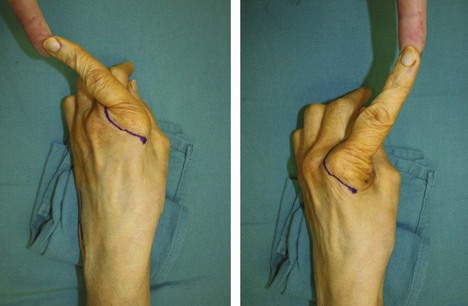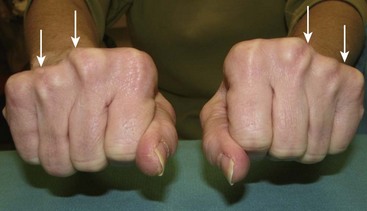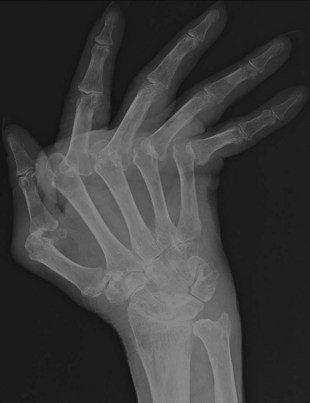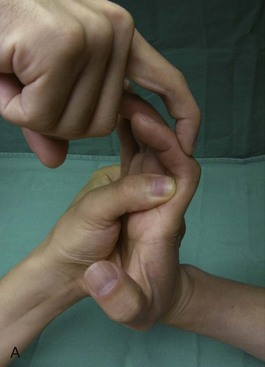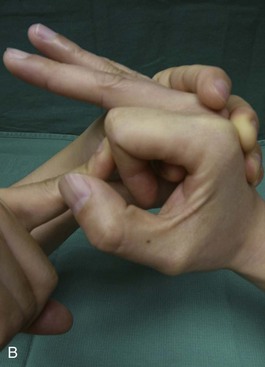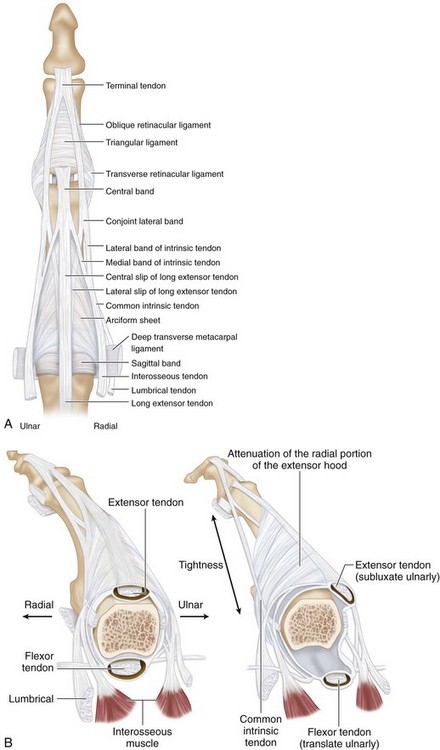Procedure 32 Crossed Intrinsic Tendon Transfer
![]() See Video 24: Crossed Intrinsic Tendon Transfer for Correction of Ulnar Deviation Deformity
See Video 24: Crossed Intrinsic Tendon Transfer for Correction of Ulnar Deviation Deformity
Indications
 Performed in rheumatoid arthritis patients who have passively correctable ulnar deviation deformity (Fig. 32-1) with associated ulnar subluxation of the extensor tendon at the metacarpophalangeal (MCP) joint (Fig. 32-2) without arthritis or subluxation
Performed in rheumatoid arthritis patients who have passively correctable ulnar deviation deformity (Fig. 32-1) with associated ulnar subluxation of the extensor tendon at the metacarpophalangeal (MCP) joint (Fig. 32-2) without arthritis or subluxation
 Ulnar subluxation of extensor tendon in chronic posttraumatic radial sagittal band injury
Ulnar subluxation of extensor tendon in chronic posttraumatic radial sagittal band injury
Examination/Imaging
Clinical Examination
 Clinical examination is to determine the condition of the MCP joint and the intrinsic tendons.
Clinical examination is to determine the condition of the MCP joint and the intrinsic tendons.
 A crossed intrinsic tendon transfer cannot be done in a patient who has a subluxed or arthritic MCP joint (Fig. 32-3). These patients need implant arthroplasty because a soft tissue procedure will not be able to hold a subluxed MCP joint in position. In addition, the patient is examined for the presence of MCP joint synovitis that can be addressed at the same operation.
A crossed intrinsic tendon transfer cannot be done in a patient who has a subluxed or arthritic MCP joint (Fig. 32-3). These patients need implant arthroplasty because a soft tissue procedure will not be able to hold a subluxed MCP joint in position. In addition, the patient is examined for the presence of MCP joint synovitis that can be addressed at the same operation.
 The intrinsic tendons should be examined for the presence of intrinsic muscle contracture (intrinsic tightness). This is done by the Finochietto-Bunnell test, which is performed by passively holding the patient’s MCP joint in full extension and attempting proximal interphalangeal (PIP) joint flexion. PIP joint flexion will be restricted in patients with intrinsic tightness (Fig. 32-4A and B).
The intrinsic tendons should be examined for the presence of intrinsic muscle contracture (intrinsic tightness). This is done by the Finochietto-Bunnell test, which is performed by passively holding the patient’s MCP joint in full extension and attempting proximal interphalangeal (PIP) joint flexion. PIP joint flexion will be restricted in patients with intrinsic tightness (Fig. 32-4A and B).
Surgical Anatomy
 The common intrinsic tendon is formed by the tendons of the palmar and dorsal interosseous muscles on the ulnar side of the digit and by the interossei (palmar and dorsal) and the lumbrical tendon on the radial side. These tendons pass palmar to the axis of the MCP joint to form the common intrinsic tendon. This tendon then divides into a medial band that inserts along with the central slip into the dorsal base of the middle phalanx and a lateral band that continues to the dorsal base of the distal phalanx (Fig. 32-5A). Contraction of the intrinsic muscles causes MCP joint flexion and interphalangeal (IP) joint extension. The radial and ulnar sagittal bands stabilize the extensor tendon, keeping it over the dorsal midline of the MCP joint (Fig. 32-5B).
The common intrinsic tendon is formed by the tendons of the palmar and dorsal interosseous muscles on the ulnar side of the digit and by the interossei (palmar and dorsal) and the lumbrical tendon on the radial side. These tendons pass palmar to the axis of the MCP joint to form the common intrinsic tendon. This tendon then divides into a medial band that inserts along with the central slip into the dorsal base of the middle phalanx and a lateral band that continues to the dorsal base of the distal phalanx (Fig. 32-5A). Contraction of the intrinsic muscles causes MCP joint flexion and interphalangeal (IP) joint extension. The radial and ulnar sagittal bands stabilize the extensor tendon, keeping it over the dorsal midline of the MCP joint (Fig. 32-5B).
Exposures
 A dorsal “lazy S”–shaped skin incision over the MCP joint is used if only one finger needs to be addressed (Fig. 32-6).
A dorsal “lazy S”–shaped skin incision over the MCP joint is used if only one finger needs to be addressed (Fig. 32-6).
 For correction of multiple fingers, a dorsal transverse incision is made over the MCP joint of the involved fingers (Fig. 32-7).
For correction of multiple fingers, a dorsal transverse incision is made over the MCP joint of the involved fingers (Fig. 32-7).
 The extensor apparatus over the MCP joint is exposed (Fig. 32-8).
The extensor apparatus over the MCP joint is exposed (Fig. 32-8).
Stay updated, free articles. Join our Telegram channel

Full access? Get Clinical Tree


